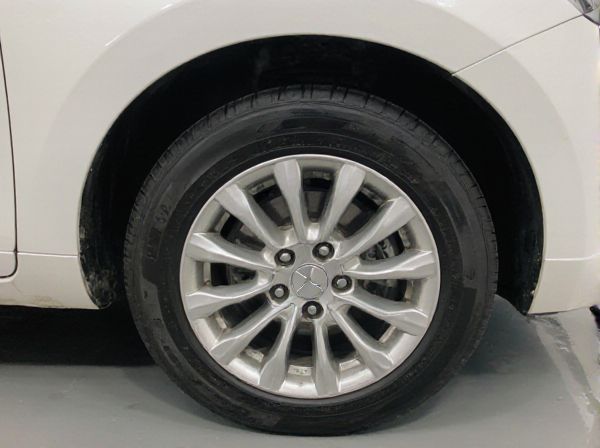
Photo illustration: Zero Offset vs Negative Offset Wheel
Zero offset wheels position the mounting surface flush with the wheel's centerline, promoting balanced handling and a neutral steering feel. Negative offset wheels have the mounting surface closer to the inside edge, pushing the wheel outward for a wider track that enhances stability and aggressive stance. Your choice between zero and negative offset impacts vehicle performance, fitment, and aesthetics, so select based on your specific driving needs and style preferences.
Table of Comparison
| Feature | Zero Offset Wheel | Negative Offset Wheel |
|---|---|---|
| Definition | Hub mounting surface aligns with wheel centerline | Hub mounting surface is closer to the wheel's inner edge |
| Wheel Position | Centered within the wheel well | Extends outward from the wheel well |
| Appearance | Flush, balanced look | Wide stance, aggressive look |
| Handling Impact | Neutral handling characteristics | Improved cornering stability with wider track |
| Fitment Concerns | Minimal clearance issues | Requires checking for fender and suspension clearance |
| Common Use | Standard factory wheel setup | Off-road, performance, and aesthetic upgrades |
Introduction to Wheel Offset
Wheel offset refers to the distance between the wheel's mounting surface and its centerline, significantly impacting vehicle handling and fitment. Zero offset means the mounting surface aligns perfectly with the wheel's centerline, promoting balanced tire positioning within the wheel well. Negative offset wheels have the mounting surface closer to the wheel's inner edge, pushing the tire outward for a wider track and enhanced stability.
What is Zero Offset?
Zero offset refers to the wheel mounting surface positioned exactly in the center of the wheel's width, where the hub faces align perfectly with the wheel's midpoint. This design ensures balanced load distribution and helps maintain the vehicle's original handling characteristics by preventing excessive stress on suspension components. Wheels with zero offset fit flush within the wheel wells, optimizing clearance and tire wear without altering the track width.
What is Negative Offset?
Negative offset refers to the position of a wheel's mounting surface being closer to the inside edge, or hub side, of the wheel. This causes the wheel to extend outward relative to the vehicle's fender, increasing the track width for improved stability and aggressive stance. Negative offset wheels are commonly used in trucks and SUVs to enhance handling and accommodate wider tires.
Key Differences Between Zero and Negative Offset
Zero offset wheels have the mounting surface aligned exactly with the wheel's centerline, promoting balanced weight distribution and maintaining original vehicle handling characteristics. Negative offset wheels have the mounting surface positioned closer to the inside edge, pushing the wheel outward and increasing the track width for improved stability and aggressive stance. The key difference lies in how the wheel sits relative to the hub, affecting clearance, suspension geometry, and overall vehicle dynamics.
Performance Implications of Wheel Offset
Zero offset wheels position the mounting surface directly in the wheel's centerline, promoting balanced handling with reduced stress on suspension components and optimized tire wear. Negative offset wheels push the mounting surface toward the inside of the wheel, increasing track width for enhanced cornering stability but potentially causing increased scrub radius and steering effort. Performance implications include changes in vehicle dynamics, such as altered steering response and suspension geometry, requiring careful selection to maintain optimal grip and control.
Impact on Vehicle Handling and Stability
Zero offset wheels position the mounting surface flush with the wheel centerline, promoting balanced weight distribution and improved steering precision, enhancing overall vehicle handling and stability. Negative offset wheels shift the mounting surface inward towards the vehicle, increasing track width for better lateral grip but potentially causing increased strain on suspension components and altered steering feedback. Choosing between zero and negative offset wheels directly affects handling dynamics, with zero offset favoring stability and precision, while negative offset can enhance cornering performance at the expense of increased mechanical stress.
Aesthetic Considerations: Flush vs Aggressive Look
Zero offset wheels sit nearly flush with the vehicle's fenders, creating a sleek, factory-like aesthetic that complements modern car designs. Negative offset wheels extend outward beyond the fender line, delivering a bold, aggressive stance favored in off-road and performance builds. The choice between zero and negative offset impacts visual width and wheel prominence, directly influencing the vehicle's perceived attitude and style.
Effects on Suspension and Brake Components
Zero offset wheels position the hub mounting surface exactly in the centerline of the wheel, promoting even load distribution on suspension components and maintaining factory-designed brake caliper clearance. Negative offset wheels move the hub mounting surface inward, increasing the distance between the wheel and suspension parts, which can introduce additional stress on control arms, wheel bearings, and alter brake caliper alignment. Such changes with negative offset wheels may lead to accelerated suspension wear and necessitate modifications to brake components for proper clearance.
Choosing the Right Offset for Your Vehicle
Zero offset wheels position the hub mounting surface exactly at the wheel's centerline, promoting balanced tire wear and compatible fitment for vehicles with standard suspension setups. Negative offset wheels place the hub mounting surface closer to the inside edge, pushing the wheel outward for a wider track and aggressive stance often favored in off-road or performance vehicles. Selecting the right offset depends on your vehicle's suspension design, brake clearance, and desired handling characteristics; consult manufacturer specifications to ensure optimal alignment and avoid issues like increased scrub radius or tire rubbing.
Conclusion: Making the Best Offset Choice
Choosing between zero offset and negative offset wheels depends on your vehicle's specific needs and driving conditions. Zero offset wheels maintain hub-centric alignment, improving handling and reducing wear, while negative offset wheels push the tire outward, enhancing stability and accommodating wider brake components. Prioritize balance between performance, aesthetics, and compatibility to make the best offset choice for your vehicle.
 caratoz.com
caratoz.com